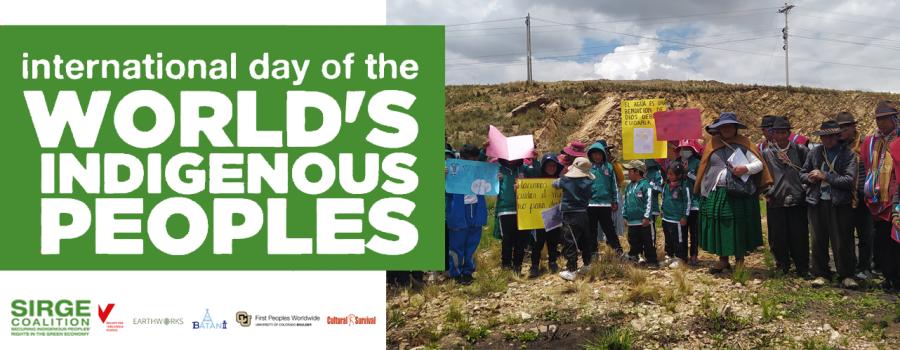
By Carolyn Smith-Morris
The coronavirus has now arrived in many Indigenous communities. The first case was reported in the Brazilian Amazon a few weeks ago. The Navajo Nation is grappling with a surge of cases. The disproportionate risk for COVID-19 infection and related harms suffered by Indigenous and minority communities has become extreme due to preexisting health conditions and inequalities across the board.
Indigenous rights leaders and defenders, already vulnerable to violent attacks due to their rural and remote locations, the greater financial and combat resources of colonizing parties, and their relatively small numbers during COVID-related community self-isolation and quarantine. Omar and Ernesto Guasiruma of the Embera people in the Naranjal township in Bolívar, Valle del Cauca, Colombia were murdered in their homes as they observed local instructions to self-isolate. Indigenous laborers in close-quartered factory jobs, such as those at the LEONI factor in Yucatán, México must work alongside symptomatic (and likely non-symptomatic) COVID-19 victims, or risk losing their jobs. And some Indigenous communities, already living on the margins of society without access to water, healthcare, or basic forms of subsistence, are completely vulnerable during this COVID-19 crisis. Now stigmatized and shunned for failing to self-quarantine, despite their lack of water and food, many Indigenous people dependent on street vending, like the Wayúu in Colombia, must search farther and farther afield for survival.
Public Health Leadership of Indigenous Peoples
Yet, if we understand infectious pandemics as community problems -- that is, as challenges for public containment more so than individualized medicine -- then we need look no further than Indigenous Peoples for models of community care.
Community-wide, self-isolation is not new to Indigenous Peoples. The Igorot peoples of Luzon, Philippines are among the Indigenous communities worldwide who practice temporary self-isolation as a way to protect its members during a crisis or after a tragedy. Solang Pooten (Igorot) explains, self-isolation practices are “for the community to cleanse, heal and recover, spiritually and emotionally. During a community ngilin [quarantine], people are strictly not allowed to roam around or make unnecessary movements or noises except for the cleansing rituals conducted. No one is allowed to enter or leave the community during the period. To signal a ngilin, pudongs (plants tied like in the picture) are conspicuously placed at every entrance of the village. Every person or anito [spirit] who comes across the pudong will be warned that the area is off-limits…. During the ngilin, cooperation and support are meaningfully observed by every person in the community. Some Igorot elders claim that igorots also practiced ngilin and pudongs during plagues to drive away bad spirits causing the disease while preventing transmission.”
Similar practices exist among the Karen people of highland Thailand, whose kroh yee [village closure] is a regular part of ritual in the sixth month of the lunar calendar. But the kroh yee can take more complicated form during serious crises, as occurred seventy years ago during a cholera outbreak.
But to sustain these critical, self-isolation practices, these Indigenous communities require access to nearby natural resources. “According to Dr. Prasert Trakansuphakon, Ban Hin Lad Nai in Wiang Pa Pao district, Chiang Rai province is a good example of self-subsistence economy. The community is capable of feeding all members throughout the year. ...Without main line electricity, Hin Lad Nai makes use of firewood and solar panels for their energy consumption. Apart from farm products, villagers have an abundance of non-timber forest products to gather from.”
Through online, webinars and social networking, Indigenous leaders are sharing traditional knowledge - and the latest biomedical and epidemiological information - to protect their communities from harm. Indigenous Climate Action and Idle No More hosted a webinar on COVID-19 and Indigenous Communities. In that Facebook Live event (a recording is still available to watch), Cree language expert Jeff Wastesicoot remembered elders’ stories of airborne disease, and who told “do not have fear” but depend on the land. Dr. James Makokis (Saddle Lake Cree Nation) reminded listeners to care for their fear and stress, their immune systems, by washing hands, staying in our homes, caring for elders, and preventing community-based spread of this disease among Indian communities. Artist, documentarian, and educator Nitanis Desjarlais (Cree/Metis,Tsimshian/Gitsan) shared lessons from her own food sovereignty work, teaching children to get dirty on the land, in forest walks, all while respecting distance from others. And Ojibway storyteller and traditional knowledge holder Isaac Murdoch spoke of “our wintering spirit”, Old Man Winter who comes in to clean. Beware, he might take people. “So the people would go into the forest, they would not be in large gatherings, they would use their own dishes.” And in this way, we see how traditions of lockdown are not new to Native Peoples.
The Cree Literacy Network, which has long published learning and teaching resources for the Cree language, now offers “Stay Home: Learn Cree”, a daily language-learning video broadcast for people self-isolating during the COVID-19 crisis.
And in another online strategy, Native women are working to heal their communities through virtual jingle dress dances. Pat Northrup, Umpaowastowin, arranged an event and someone posted it on Facebook with the hashtag #jinglehealing. “Wear your jingle dress at home and be connected,” the posting said. “Remember the reason we were given this dance.” According to Dan Kraker’s coverage on Minnesota Public Radio, Native American women from Pennsylvania to Nebraska to Ontario to Northrup’s apartment in northern Minnesota joined in. “This isn’t just an Anishinaabe prayer. This is an ‘all-people’ prayer,” said Northrup, 70, who is Dakota, widow of the late Ojibwe author Jim Northrup. “The virus isn’t going to have prejudice,” she said. It will affect all people. “So that’s what the prayers are for."
Brenda Child, a member of the Red Lake Nation, historian, and American Indian Studies professor at the University of Minnesota, says the jingle dress may have been part of the Ojibwe response to the 1918-1919 Spanish Flu pandemic. “Ojibwe women were defying the U.S. government when they developed the dance, Child said. At the time, the government forbade ritualistic dancing on reservations. "They were doing the kinds of cultural things ... that they knew helped them through terrible times,” said Child. “And Ojibwe people believe in the healing power of music and dance — that music and dance are not just something we enjoy that are pleasant. But it's very integrated into Ojibwe culture. It's very much a part of how we live."
Tribal communities all over the world are showing leadership in acting swiftly to protect their communities, even where some individual freedoms are curtailed. The Lummi Tribe, whose reservation is located outside of Seattle, Washington where the first US Covid-19 case was confirmed in January, started preparing for COVID-19 as soon as the virus first appeared in Wuhan, China, in late 2019. The Lummi nation’s early preparation for COVID-19 has probably mitigated the devastating impact of this disease in their community. Other reservation communities -- like the Cherokee and Navajo Nations -- also showed early leadership, with Tribal governments acting to transform gymnasiums and job-training facilities into satellite hospital units, issuing citations to those who violate stay-at-home orders, and banning larger gatherings before the U.S. federal government chose to do so.
As the world moves toward the peak of this COVID pandemic, our resolve to protect our larger communities must be strong. Traditions of community healing learned over millennia by Indigenous Peoples are helping, and must be respected and protected.



